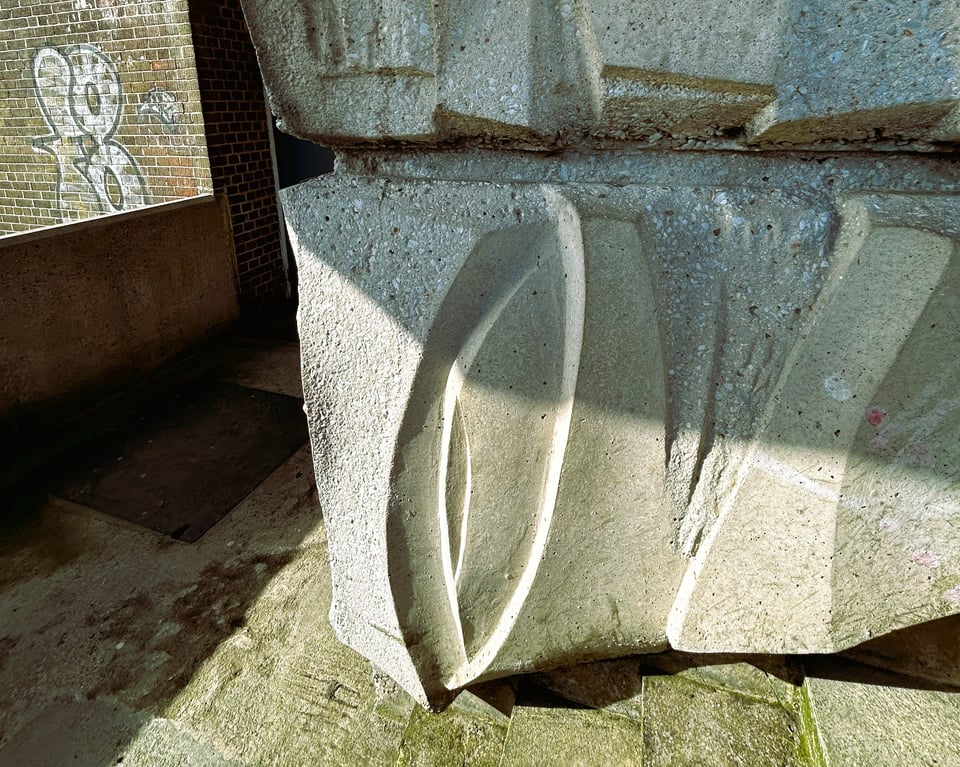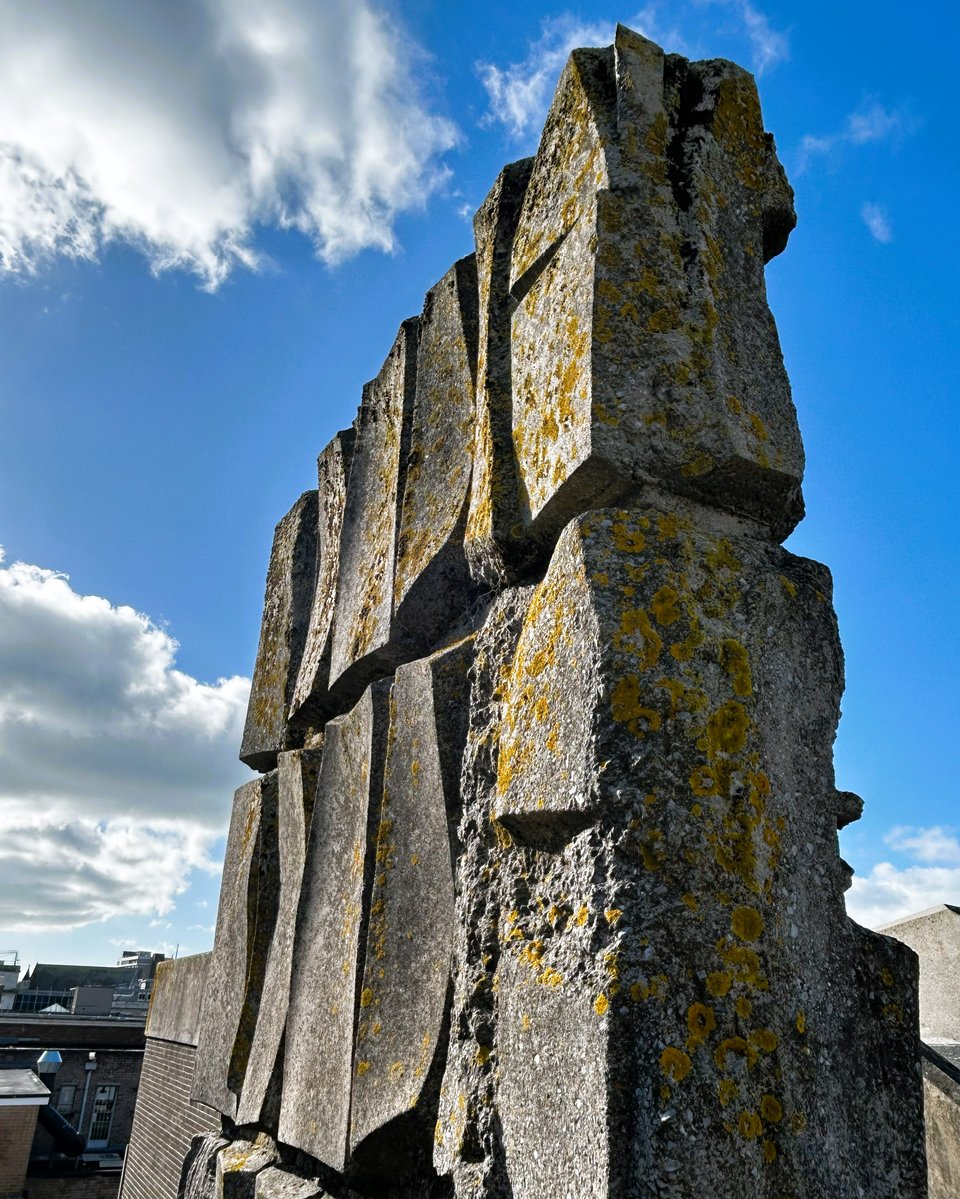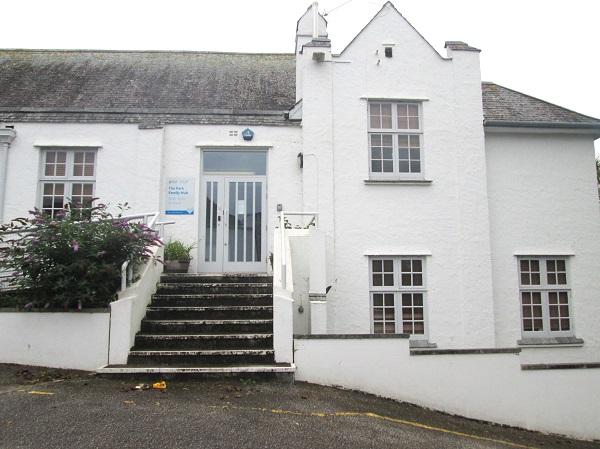Field Notes: 12 March 2025
Finding unexpected standing stones in a multi-storey carpark, and other rather utilitarian structures.
My deep dive into Sir Geoffrey Jellicoe’s 1960 Civic Hall for Totnes (£) is now live for paying subscribers. A paid sub is £3 a month, and helps cover my time and expenses like train fares.
As part of checking a theory for the Civic Hall long read, I went over to Plymouth on 27 February. I have to admit I’m almost avoiding Plymouth, and not just because I’m an Exeter girl. No, I’m circling Plymouth as a topic because it is so damn big.
Plymouth’s urban standing stones
At the end of February, I wanted to do a loop around the courts, the lido and the civic centre. I got sidetracked several times by some specific buildings. And by a lichen-coated carpark staircase.
The top of the stairs’ central column caught my eye in a gap between Marshman Warren Taylor’s 1975 Moneycentre building and Chapman Taylor’s 2001 Drake’s Circus shopping centre. Was it carved, or badly weathered?
Up close, and I discovered it was both.

The column at the lowest levels is a pale cream mix of unpolished and polished concrete. Although discoloured and graffitied, the bas-relief retains some hint of Hepworth as an inspiration.
Then at the top, the smooth concrete has been exposed to the elements for perhaps 50 years. Here lichens are blooming, and bits of dark grey concrete have weathered away, so the shapes look more like a giant stack on the moors.

Was it deliberate? Did a city architect, stuck with making a carpark stairwell visually interesting, decide to play with how the weather would distress the bas-relief? It feels unlikely. But equally the different finishes suggest some plan was in play.
The carpark has absolutely no other merit: it’s a purely utilitarian block. If it had been a rainy day, I might not have even noticed the bas-reliefs.
This is why Plymouth is something I am slowly edging towards writing about: there’s simply so much of it to explore.
Hope Cove
Hope Cove breakwater in South Devon was built in 1924. It’s another piece of utilitarian design with no aspirations to do anything but its job. It’s just there to shelter the harbour by breaking up Atlantic rollers as they come in. You might know it from this stunning - and dangerous - sequence in The Supergrass (1985).
The breakwater is starting to fail, and a charity has been set up to save it. Peter Richardson has created a director’s cut of The Supergrass which will be screened at the nearby Malborough Village Hall this Saturday. Learn more and get tickets here.
Local news of C20th buildings
In which I fight my way through local ad-laden news sites to find stories about twentieth century buildings.
Falmouth’s 1926 magistrate’s court facade
The magistrate’s court on Park Terrace in Falmouth was built in 1926, and is in a Conservation Area. After it closed as a court the council converted it to a family hub. With that closing, Cornwall Council have sold it to Falmouth Methodist Church Trust, who wanted to demolish it and build a new church on the site. Some kind of compromise has been reached as new proposals suggest keeping the façade.

Plymouth plants ‘huge trees’ on Armada Way
Having taken down the mature trees that had done much to soften the uncompromising wide boulevard of Armada Way, now the council are putting new trees back. I’m sure it was all necessary, but it was not communicated well.

Huge trees set to transform Plymouth city centre - Plymouth Live
'Start of the re-greening of Armada Way'
People are also rather concerned about the high costs of upgrading Plymouth city centre.
RIBA South West shortlist
The RIBA shortlist for the southwest has been published. Obviously, this is outside the 1920-1980 time frame I’m focusing on. I quite like both the Story of Emily museum in St Ive and the Two Family House in Mawgan Porth.
If you know of an event or news item you think I should know about, you can contact me on Bluesky.
I’m still working on my next deep dive: I need to stop being sidetracked by other buildings and structures.